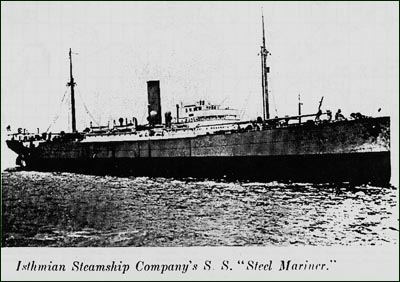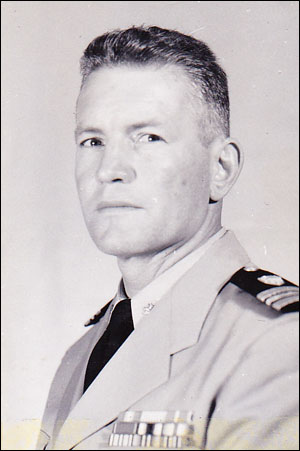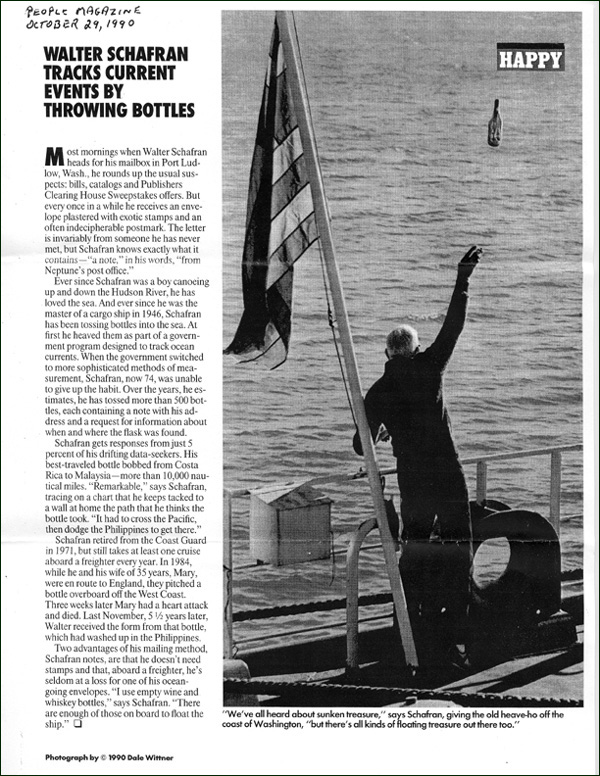Note..... Capt. Schafran has sent me copies of his A Wartime Voyage
and Notes From Neptune's Post Office. With his permission, I am going to publish some
excerpts from his books in this space.
Note..... Excerpt #1..... I am going to start by publishing
the first three paragraphs of A Wartine Voyage.
A Wartime Voyage
Around The World
36,289 Miles
290 Days
SS Steel Mariner
by W.C. Schafran
DEDICATED IN LOVING MEMORY OF
MY WIFE, MARY,
WHO LOVED THE SEA AND SHIPS
CHAPTER 1 - THE ISTHMIAN SHIPS
The Japanese attack on Pearl Harbor was still searingly fresh in the minds of all Americans,
the pain somewhat eased by the overwhelming victory over the Japanese fleet at the Battle of
Midway in early June 1942, when the Isthmian Steamship Company's SS STEEL MARINER commenced
loading cargo of lend-lease war material in Baltimore, Maryland, for the Soviet Union. She
had just arrived at a loading berth after coming from Bethlehem Steel's Key Highway Shipyard
where a gun had been mounted at the stern, two 20 MM guns on the bridge,
and two 20 MM guns on the boat deck. A U.S. Navy gun crew consisting of one officer and thirteen
enlisted men was to report aboard a few days later. Although traditionally the hulls of Isthmian
Line ships above the waterline were painted gray, the deck houses white, and the funnel, masts
and booms buff, she was now war-time gray all over. This was how I found her when I came aboard
as Second Mate on 7 August 1942.
The SS STEEL MARINER was one of 28 freighters owned and operated by Isthmian Steamship
Company, New York, New York, then a subsidiary of United States Steel Corporation. They were
built in the years 1920 through 1921, 14 by Federal Shipyard at Kearny, New Jersey, and 14 by
Chicksaw Shipbuilding and Car Company at Chicksaw, Alabama.
While not a large ship by today's standards, STEEL MARINER (and her sister ships) was of
average size for her day, being of 5,690 Gross Registered Tons, 3,450 Net Registered Tons,
and 9,400 tons Summer Deadweight. Her other registered dimensions were: Length, 424.2 feet
(about 440 feet overall); Breadth, 56.2 feet; and Depth, 26.5 feet; horsepower was 3,100.
These ships had trim lines and were known throughout the U.S. Merchant Marine as being
“good sea-boats.” And although the company might haggle over a few hours of overtime, it
seldom questioned expenses for the maintenance and upkeep of its ships.
Note..... Capt. Schafran goes on to explain "well deck" and "flush deck" ship
designs.
Note..... Excerpt #2.....
CHAPTER 2 - REPORTING ON BOARD
Normally, when first joining a ship, It is good seaman-like practice to familiarize
oneself with all the parts of the ship and her equipment. I recall that when reporting
aboard a ship for my first assignment as Third Mate, the Chief Officer ordered me to
locate and identify every sounding tube, reach-rod (remote control to an inaccessible valve)
and vent pipe on the weather deck. But this wasn't necessary aboard STEEL MARINER for
I had served aboard sister vessels for several years as able seaman and Third and Second
Mate. I did, however, immediately check the master gyro compass and repeaters and the ship's
chronometers, all of which are traditionally the responsibility of the second mate. The
chronometers, on which celestial navigation depends, must be wound daily at the same time--and
God help the second mate who lets one run down!
Another important responsibility of the second mate is the vessel's charts and nautical
publications which must be adequate for the coming voyage and corrected up-to-date by the
latest Notice to Mariners. Additional in port duties include the supervision of the loading
and stowage of the cargo.
As was noted previously, cargo was being loaded for the Soviet Union. At a time early
in the War, when merchant ships were easy prey to marauding German submarines, I was much
relieved to find that there were no items of an explosive nature in our cargo. It consisted
of disassembled railroad rolling stock--the sides, ends and roofs of box cars were stowed
separately as were the wheels and flatbeds--miscellaneous steel products and some food stuffs.
The cargo was to be discharged at two ports in the Persian Gulf, Bandar Shahpour
(now called Bandar Khomeini) in Iran and Basrah in Iraq, for transshipment to the Soviet Union.
Note..... Excerpt #3.....
One at a time, we stepped up to the table, showed the Shipping Commissioner our license
and/or our seaman's papers and affixed our signatures to both copies of the Shipping Articles
of Agreement. Sitting at the table was the ship's Master, Captain George Georgopoulos, with whom
the agreement was made. And although signing-on signaled the beginning of the voyage for the
crew, for statistical purposes this voyage, Voyage 59, began on 18 July 1942, the day
following the day all inbound cargo from the previous voyage had been discharged.
Captain George Georgopoulos obviously was of Greek descent, and he was no stranger to
me as I had sailed with him as Third Mate on SS STEEL INVENTOR prior to the outbreak of
World War II. Captain Georgopoulos' appearance belied his sharp intelligence, keen
business acumen and capable seamanship. His appearance was far beyond any comparison
with the stereotype Hollywood concept, being less than average in height and somewhat
pudgy, with an olive complexion, black mustache and hair, and a round bald spot appearing
at the top of his head.
Nor did he dress like a captain. His most common attire was a pair of baggy brown trousers,
a shirt with a detachable collar (Do you remember them?) but without the collar and tie,
and an old blue uniform jacket. He smoked cigarettes and had the habit of holding a cigarette
at the very center of his lips. He would speak with the cigarette in that position, the ash
growing longer and eventually dropping on the front of his uniform jacket. But again, his
appearance was deceiving.
Note..... Excerpt #4.....
CHAPTER 3 - PREPARING FOR SEA
19 August 1942 saw the last ton of cargo stowed and secured below decks. We were lucky not
to have had deck cargo. Aside from the normal problems associated with a deck cargo, a
deck cargo during war time created many additional hazards from flying debris should the
ship be struck by torpedo, bomb, or shell. As each hatch was finished, the hatch beams were
lowered into their sockets, the wood hatch covers slid into place, and three tarpaulins
stretched over the wood covers. The overhang of the tarps were neatly folded and tucked
behind cleats welded at an angle to all four sides of the hatch coaming. Then, long,
flat-steel bars, called battens, about 1/2” x 4” x 20', were forced between the cleats
and the tarps. And lastly, several flat-steel cross-battens, each as long as half the
width of the hatch, shaped at one end to catch the flange of the hatch coaming and at the
other end so as to meet at the middle of the hatch and butt against the one from the other
side, were laid across the hatch and bolted together.
This “battening-down” of the hatches is done by the deck department under directions of
the bo's'n. But there is one final job to be done, and traditionally this belongs to the
ship's carpenter. When all battens on a hatch are in place, along comes the carpenter with
a gunny sack of wood wedges and a maul and he will proceed to drive a wedge between each
cleat and side batten, tightly securing the tarps.
With the hatches now secured, the deck department begins to lower and cradle the booms,
stripping and stowing the blocks and runners (the moving wire that raises and lowers the cargo).
When the booms are lashed in their cradles and all cargo handling gear stowed away, the
ship generally is ready to go to sea (Sometimes, if a hatch is not completely filled with
cargo, one or two hatch covers are left open and as a boom is lowered, the running gear
is stripped right into the hatch).
Note..... Excerpt #5.....
So, the night before we were to depart Baltimore I knew that the ship would be anchoring in
New York's Upper Bay. I was born and grew up in New York City, and my parents were still living in
Manhattan, so I telephoned and told my mother that the ship would be anchored in the Upper Bay but
that I would not be permitted to go ashore. I suggested that if she would ride the Staten Island
ferry, which crosses the Upper Bay, she might catch a glimpse of the ship. She told me later
what happened.
Borrowing a pair of binoculars, she boarded a ferry and made a trip to Staten Island, searching
among the many ships at anchor for STEEL MARINER, but with no success. She remained on the ferry
for the return trip and three more round trips, all the time peering through the binoculars at
the ships at anchor, until her actions aroused the suspicions of two naval intelligence officers
who had been observing her. As my mother told it, she was quite startled to be questioned by the
two officers and to be suspected of intelligence gathering for the enemy. The naval officers
weren't quite sure of her explanation that she was only trying to see her son's ship, but they
accepted it, and when the ferry again docked at the Battery, she hurried home.
Note..... Excerpt #6.....(From CHAPTER 4 - UNDERWAY, CHESAPEAKE BAY TO NEW YORK)
Arriving off Sandy Hook the same day, each ship of the convoy took on a pilot and in
single file proceeded to a designated anchorage in Upper New York Bay. If Lynnhaven Roads
was thought to be crowded, Upper New York Bay was unbelievably “chockablock” with anchored
vessels, many flying the flags of allied countries. How in the world would my mother ever
find my ship amongst this multitude?
But as it turned out, it wasn't even necessary. Amazingly, the purser and I, because we both
had family in New York City, were given permission to go ashore. Because of the rapid build
up of the Merchant Marine, many of the men manning the ships had never been to sea before,
and the purser was one of them. He had been to one of several schools run by the federal
government and had been issued a uniform. He was eager to impress his family and neighbors,
so when the water taxi pulled alongside the gangway, he emerged in full uniform.
The water taxi called at several anchored ships before heading for its dock on the East River
side of the southern tip of Manhattan Island. It was now growing dark. Mooring outboard of
several water taxis already at the dock, we had to cross all of them to reach the dock, an
old wooded structure which looked like it had been there from when the Dutch governed New
York. I was ahead of the purser and jumping the short distance from the last boat rail to the
dock, started walking up the dock. After taking a few steps (it was now dark), I saw his uniform
cap on the dock alongside an opening in the dock surface made by two broken planks. A few seconds
later the purser came clawing his way up through the opening, having jumped from the boat rail
right through the opening and into the dirty East River. Needless to say his uniform was ruined,
but miraculously he had missed all the structural members beneath the dock and was unhurt.

|





